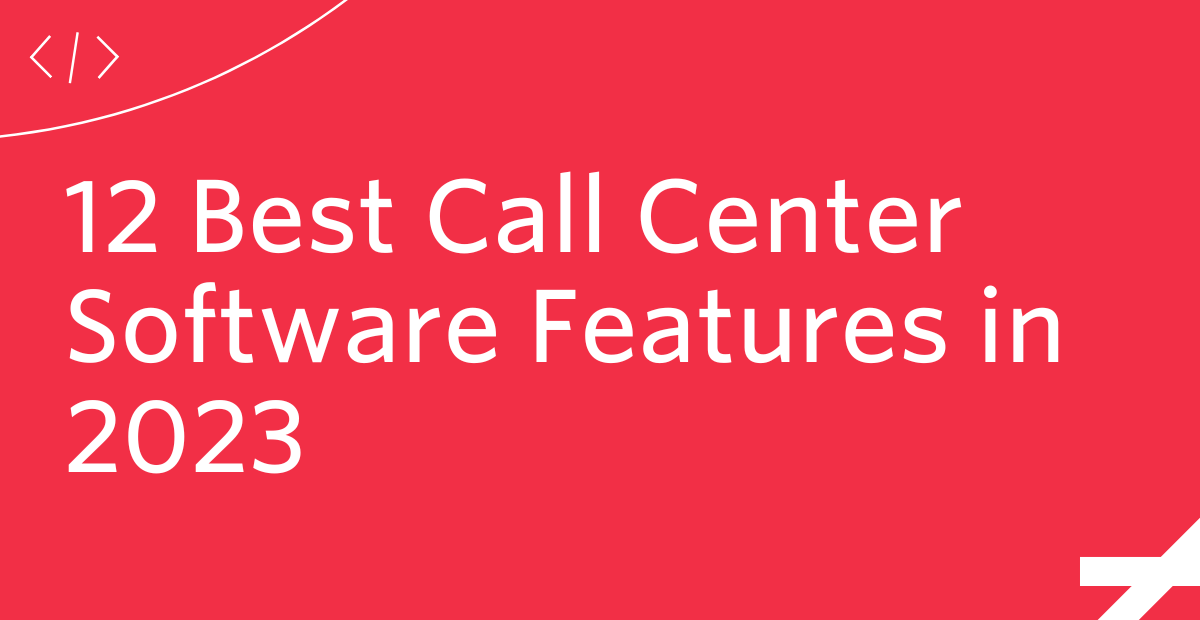12 Best Call Center Software Features in 2023
Time to read: 5 minutes

Every call center is different. Some offer simplified services to make products more user-friendly, while others stuff everything into the solution to make it as feature-rich as possible. Depending on your business' size and use case, more isn't necessarily better—instead, you should focus on the best call center software features your business actually needs.
Below, we'll walk you through the top call center software features in 2023. These are the no-fluff features that will impact your day-to-day operations, enhance your agents’ life, and improve the customer experience. You might not need all these features for your business now, but consider where your business might be in 1, 5, or 10 years.
While you can always migrate to another call center solution down the road, it's easier to invest in one call center software now and let it scale with your business. This will help you retain your agents' expertise and workflows and might help you score legacy pricing.
Call center vs. contact center
First, let's get on the same page about call centers vs. contact centers. While often interchangeable, these terms don't mean the same thing.
Call centers focus on inbound (support) and outbound (sales) communication over the phone. Before, this meant voice calls, but now that includes SMS (texting).
Contact centers, on the other hand, provide more channels and an omnichannel experience. These often include social media channels, video, chat, email, messaging applications, push notifications, SMS, and voice.
Call centers are often more simple solutions, but we believe a contact center is almost always the better choice. It offers customers increased options for contacting your business, which could be the difference between keeping or losing a customer.
12 best call center software features
1. Interactive voice response (IVR)
IVR (also known as a phone tree) lets you build an automated telephone system for incoming callers using voice and touch commands. This allows customers to self-serve, find information, and get help as quickly as possible.
A simple example of IVR in action is when you make a call and hear the following: "Press 1 for store hours. Press 2 to talk to an agent. Press 3 to hear your options again."
Want something more sophisticated? IVR systems can let you respond with voice commands and take more actions. For example, you might be able to view your monthly usage of a service, pay bills, or update your account information. Learn how to build an IVR solution with Twilio.
2. Smart routing
Smart routing lets you direct incoming calls to the right destination from the get-go—no more "let me transfer you to the right department." For example, Twilio's TaskRouter API lets you create skill-based routing with escalation and fallback rules:
- Route calls to the right agents depending on any attribute you apply
- Push the right tasks and conversations to the best-suited agents
- Decide how many tasks an agent can handle concurrently and set different limits per channel
- Define escalation logic to ensure customers get timely attention
3. SMS
SMS lets your customers initiate or respond with text messages to your company. For customers who prefer text-based conversations, this will make them more likely to reach out to your business. Your agents will also be able to handle more text conversations concurrently, allowing you to respond faster and solve more customer inquiries.
4. Call recording
Call recording with call center software lets you record customer calls. You can record these calls for any of the following:
- Training
- Verification
- Agent protection
- Customer protection
- Legal purposes
5. Power dialers
Power dialers let you automatically dial stored numbers from your phone lists. It's not a robocall—it just takes the manual entry away from your agents having to push buttons and click a dial. Power dialers will continue dialing numbers until a user picks up, making the most of your customers' and agents' time.
6. Computer telephony integration (CTI)
CTI technology lets your phone and computer interact with your call center. This gives your devices features like automatic dialing, routing, call monitoring, screen pops, and more. Employees can now use their smart devices for customer calls instead of less-powerful (less-integrated) legacy phone systems.
7. Call whispering
Call whispering lets your admins monitor calls between agents and customers to offer help. Your managers might whisper helpful advice in the ear of an employee who's struggling or new to the job, or they might just listen in so they can provide feedback and direction. And if things go off the rails, admins can even take over the call.
8. Integrations
Integrations of your call center with the rest of your tech stack let you create a seamless experience for your customers and agents. Ideally, these should connect to your customer relationship management (CRM) platform to keep up-to-date customer records of all your interactions. Agents should be able to make calls, send messages, and update records straight from your company's CRM tool.
9. Transferring
Transferring seems like a simple feature (because it is), but it's one you'll want to ensure your call center software provider offers because it lets you route calls when necessary. The software should make it quick and easy to transfer calls to the appropriate party without too much fuss on the part of the agent or customer.
10. Analytics
Analytics are also crucial, as these allow your call center to provide holistic and real-time analytics that let you gain insights into your team's performance. These insights should tell you information about your agents and the call center as a whole. For example, you should be able to see average wait times, the number of concurrent conversations, and the length of current conversations.
11. Call presence
Call presence lets you see the status of your agents. This gives your agents the knowledge they need to effectively transfer calls and helps your intelligent routing only send calls to available employees. For example, if an agent is already on the phone with a customer, they won't be able to accept a transfer. Or if they need to take a minute to visit the restroom, they can update their call presence to ensure no new conversations get sent their way while they're gone.
12. Call parking
Call parking lets you temporarily put a call on hold and resume the conversation from another device or end point. For example, you might start a conversation on your computer but need to transfer it to your mobile device or have another emergency and need to park a call until another agent is available to pick it up.
Get started with Twilio Flex
Twilio Flex is more than a call center—it's a flexible cloud-based contact center. It allows you to provide personalized experiences and an omnichannel presence to your customers on a global scale.
Want to see Flex in action? Submit your request for an interactive demo, and one of our experts will give you a hands-on walk-through of the platform and how it can revolutionize the way you communicate with customers.
Related Posts
Related Resources
Twilio Docs
From APIs to SDKs to sample apps
API reference documentation, SDKs, helper libraries, quickstarts, and tutorials for your language and platform.
Resource Center
The latest ebooks, industry reports, and webinars
Learn from customer engagement experts to improve your own communication.
Ahoy
Twilio's developer community hub
Best practices, code samples, and inspiration to build communications and digital engagement experiences.

